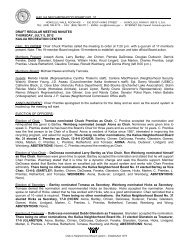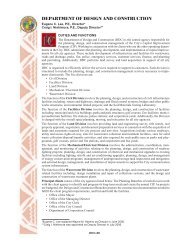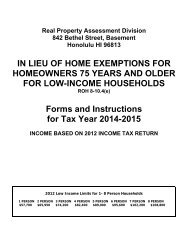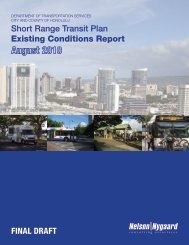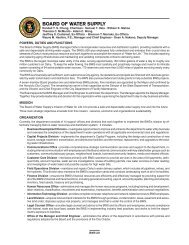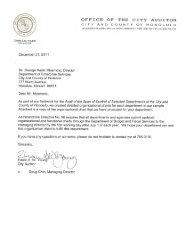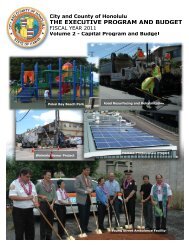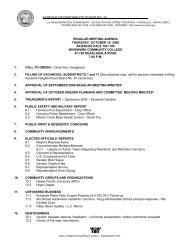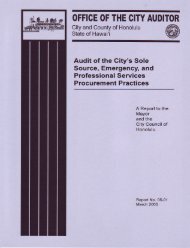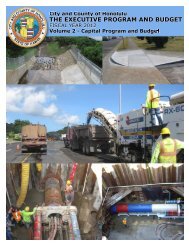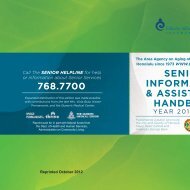Taxi Service Plan - City and County of Honolulu
Taxi Service Plan - City and County of Honolulu
Taxi Service Plan - City and County of Honolulu
- No tags were found...
Create successful ePaper yourself
Turn your PDF publications into a flip-book with our unique Google optimized e-Paper software.
Table <strong>of</strong> Contents<strong>Taxi</strong>cab <strong>Service</strong> <strong>Plan</strong> ...................................................................................................................1Section 1. Current Use <strong>of</strong> <strong>Taxi</strong>s to Provide TheH<strong>and</strong>i-Van <strong>Service</strong>................................................1Section2. Exp<strong>and</strong>ed Use <strong>of</strong> <strong>Taxi</strong>s <strong>and</strong> Other Non-DedicatedProviders for TheH<strong>and</strong>i-Van <strong>Service</strong>..............................................................................................5Section 3. Establishment <strong>of</strong> a User-Side <strong>Taxi</strong> Subsidy Program...................................................10Table <strong>of</strong> FiguresFigure 1: Contractual Rate Structure for TheCab..............................................................................4Figure 2: Vendor Rates for Four Companies......................................................................................9Figure 3 Cost-Benefit Analysis <strong>of</strong> Subsidized <strong>Taxi</strong> Program............................................................17<strong>Taxi</strong>cab <strong>Service</strong> <strong>Plan</strong>Page
<strong>Taxi</strong>cab <strong>Service</strong> <strong>Plan</strong>Both <strong>Honolulu</strong>’s Department <strong>of</strong> Transportation<strong>Service</strong>s (DTS) <strong>and</strong> Oahu Transit <strong>Service</strong>s, Inc.(OTS) have expressed an interest in exp<strong>and</strong>ingthe use <strong>of</strong> taxicabs for TheH<strong>and</strong>i-Van in order toimprove the cost-efficiency <strong>of</strong> TheH<strong>and</strong>-Van operations,as well as to increase the mobility options forTheH<strong>and</strong>i-Van customers (<strong>and</strong> potentially otherpersons requiring specialized transportation). Therationale <strong>and</strong> recommended action plans for suchare detailed in this <strong>Taxi</strong>cab <strong>Service</strong> <strong>Plan</strong>.This <strong>Taxi</strong>cab <strong>Service</strong> <strong>Plan</strong> is organized into threesections:• Section 1 discusses how taxis are currentlyused by OTS for TheH<strong>and</strong>i-Vanservice. The OTS procurement process isaddressed, including a discussion <strong>of</strong> thecontract that exists between OTS <strong>and</strong> itstaxi contractor, TheCab. Backgroundinformation on TheCab is provided,together with an assessment <strong>of</strong> TheCabservice that was presented in a previoustask.• Section 2 discusses how other transitagencies utilize taxis <strong>and</strong> other non-dedicatedservice providers in an integratedfashion to improve the overall cost-efficiency<strong>of</strong> their ADA paratransit service,<strong>and</strong> how TheH<strong>and</strong>i-Van might specificallybenefit from these models. Includedin this discussion is the notion <strong>of</strong>utilizing multiple providers; prospectiveresources <strong>of</strong> non-dedicated service arealso identified.• Section 3 focuses on the exp<strong>and</strong>ed use <strong>of</strong>taxis in a supplementary, non-ADA usersidesubsidy taxi program. A number<strong>of</strong> transit agencies across the U.S. haveimplemented such programs primarilyas a way to shift dem<strong>and</strong> from theirADA paratransit services to a lower-costalternative service, while at the same timeproviding more mobility options fortheir ADA paratransit customers.Section 1.Current Use <strong>of</strong> <strong>Taxi</strong>s toProvide TheH<strong>and</strong>i-Van <strong>Service</strong>OTS, the contractor responsible for the day-todaymanagement <strong>and</strong> operation <strong>of</strong> TheH<strong>and</strong>i-Van, currently contracts with TheCab to serve asmall portion <strong>of</strong> the ADA paratransit trips. Approximatelythree percent <strong>of</strong> TheH<strong>and</strong>i-Van’s totalADA paratransit trips are provided through thiscontract, or 24,617 trips in FY2005, at a cost <strong>of</strong>approximately $466,000. This represents a morethan 30% increase in taxi trips since FY2003, whiletotal TheH<strong>and</strong>i-Van ridership was essentially flatduring the same period. The unit cost per tripsfor vans was $23.40, versus the taxi cost per trip<strong>of</strong> $18.90, partly due to the shorter average taxitrip lengths.Trips assigned to TheCab by OTS include bothsubscription trips <strong>and</strong> dem<strong>and</strong> trips. Over 90% <strong>of</strong>the ADA trips assigned to TheCab are ambulatory<strong>and</strong> are served by approximately 90 designated taxidrivers. These are drivers who have been speciallytrained to provide this service. Only those whohave been associated with the company for at leastsix months are eligible to participate in the OTScontract. Training includes a two-hour orientationwith TheCab management, <strong>and</strong> OTS-providedsensitivity training.The remaining trips, taken by non-ambulatorycustomers <strong>of</strong> TheH<strong>and</strong>i-Van, are served on accessibletaxis. TheCab owns four accessible Ford
<strong>Honolulu</strong> Paratransit <strong>Service</strong> StudyWindstar minivans. All four vehicles are over fouryears old - all have significant maintenance issues.Consequently, it is not uncommon for one or more<strong>of</strong> the vehicles to be unavailable. For example,during our site visit in August 2005, only two <strong>of</strong>the four taxis were available to provide TheH<strong>and</strong>i-Van service, <strong>and</strong> again in January 2006 one <strong>of</strong>the vehicles was out <strong>of</strong> service. In contrast to theregular taxis, which are operated by independentcontractors, these accessible taxis are operated bycompany employees. Initially, they were operatedas metered taxis. However, the meters havesince been removed, <strong>and</strong> they are now operatingas non-metered, for hire (hourly-rate) vehiclessubject to PUC regulations. Further, for OTS,they are no longer used in a non-dedicated role,but rather are assigned to dedicated runs. (Moreon this below.)Virtually all the trips that are assigned by OTS toTheCab are trips that the larger OTS vehicles cannoteasily reach because <strong>of</strong> the street configurationor other physical constraints. While it has beenreported that overflow trips, i.e., trips that cannotbe scheduled onto OTS’ dedicated fleet due tocapacity constraints, are also assigned to TheCab,we saw no evidence <strong>of</strong> this during our site visits.(This was also confirmed in interviews with OTS’schedulers <strong>and</strong> dispatchers.) That being said, taxisare utilized – upon occasion - by dispatchers onthe day <strong>of</strong> the trips for back-up duties. However,the OTS dispatchers have been instructed to keepthis to a minimum <strong>and</strong> to use their own fleet asmuch as possible. Accessible taxis are generallynot available for a back-up role as they have beenfully assigned to dedicated runs. Thus, the OTSdispatchers have no back-up taxi resources fornon-ambulatory trips.Until the summer <strong>of</strong> 2005, all trips – both ambulatory<strong>and</strong> non-ambulatory – that fit the abovecriteria (narrow streets or occasionally as back-up)were assigned to TheCab, generally the night beforethe trips were to be taken. All <strong>of</strong> the ambulatorytrips were then dispatched onto the taxis operatedby the specially-trained drivers, while all the nonambulatorytrips were dispatched onto the accessibletaxis. TheCab’s manager reported to OTSthat the number <strong>of</strong> non-ambulatory trips assignedto TheCab was insufficient to cover the capital<strong>and</strong> operating costs <strong>of</strong> the accessible taxis. Whiledispatching ambulatory trips to fill the holes mayhave helped address this problem, it was decidedinstead that these vehicles should be converted tonon-metered, hourly-rate dedicated runs. And,while this action did solve the issue <strong>of</strong> coveringcosts, it removed the accessible taxis from servingin a back-up role.Currently, OTS schedulers develop schedules forTheCab’s accessible vehicles (that are available)<strong>and</strong> identify other trips for assignment to regulartaxis, as noted above, on the day before the tripsare to be served. These driver manifests <strong>and</strong> list <strong>of</strong>ambulatory trips are faxed to TheCab during theevening. OTS dispatchers also call TheCab on theday <strong>of</strong> the trip for individual ambulatory trips incases where OTS vehicles (that are running late,for example) cannot serve the trip.TheCab is responsible for confirming the ride witheach customer before dispatching the trip to thedrivers. Riders pay the $2 fare or provide a couponto the driver, <strong>and</strong> sign a trip voucher that has beencompleted by the driver, detailing informationsuch as pick-up/drop-<strong>of</strong>f times <strong>and</strong> addresses <strong>and</strong>the meter charge. <strong>Taxi</strong> drivers submit to TheCaban invoice for the drop-charge plus the meter rate(“total trip cost”) minus the $2 fare. For example,Page
if the total cost <strong>of</strong> the trip is $20 <strong>and</strong> the driverhas been paid a $2 cash fare, they will receive $18minus a 5% administrative/h<strong>and</strong>ling fee chargedby the company for each trip. For this same $20trip, if the driver received a coupon that theyhave submitted with the voucher, they will bereimbursed $20 minus the 5% administrative fee.TheCab then invoices OTS for the full cost <strong>of</strong> thattrip minus the fare.For the accessible cab service, even though thedrivers are paid on an hourly basis, TheCab billsOTS the cost <strong>of</strong> the trip based on the odometer(there is no meter rate involved, since these arePUC-regulated vehicles). So, for example, for asix mile trip, the agreed upon rate is $19.25. The-Cab bills OTS $19.25 plus a $10 surcharge if thepassenger uses a wheelchair, which is the majority<strong>of</strong> these trips.As mentioned above, the employee drivers <strong>of</strong>TheCab’s dedicated runs are paid on an hourlybasis. Since TheCab is paying these employees onan hourly basis, it is in the company’s interest tokeep the cabs in revenue service for the duration <strong>of</strong>the drivers’ shift to the greatest extent possible.DTS regards the payments to TheCab as “out-<strong>of</strong>pocket”expenses. Consequently, DTS staff hasdirected OTS to focus on assigning shorter trips toTheCab, to minimize the average “out-<strong>of</strong>-pocket”cost per trip.<strong>Taxi</strong> <strong>Service</strong>sProcurement Process <strong>and</strong> ContractThe current contract with TheCab is an extension<strong>of</strong> an earlier procurement process in which TheCabwas the only company to respond. Some <strong>of</strong> thenoteworthy features <strong>of</strong> the procurement processinclude:• The procurement document was not disseminatedto all relevant PUC-regulatedcompanies, even though the contractallows for the use <strong>of</strong> PUC-regulatedvehicles, <strong>and</strong> in fact a portion <strong>of</strong> the taxiservice is currently provided in this way.This is significant because most companiesthat have wheelchair accessiblevehicles have chosen to be PUC-regulatedrather than operate as taxis, as theyhave more control over the drivers thanthey would if they were independentoperators. The companies can developschedules <strong>and</strong> assign trips to the driverswithout allowing them the choice <strong>of</strong>whether to take the trips or not.• The solicitation indicated that preferencewould be given to companies that haveaccessible vehicles. While this ostensiblywas included as a means <strong>of</strong> exp<strong>and</strong>ingthe pool <strong>of</strong> accessible taxis on the isl<strong>and</strong>,it may have had the effect <strong>of</strong> discouragingother companies from bidding.• Although OTS was originally interestedin contracting with a single company inorder to simplify administrative procedures,management is reportedly moreopen to exp<strong>and</strong>ing the number <strong>of</strong> contractedcompanies.<strong>Taxi</strong>cab <strong>Service</strong> <strong>Plan</strong>Page
<strong>Honolulu</strong> Paratransit <strong>Service</strong> StudyFigure 1:Contractual Rate Structure forTheCab2004 2005*Flag Drop Rate $2.25 $2.45Per mile charge (or fraction there<strong>of</strong>)$2.40 $2.80No-Show Rate (<strong>City</strong>) $10.00 $10.00No-Show (Rural - beyond Pali,Wilson <strong>and</strong> H-3 Tunnels, WaimanoHome Road, Lunalilo HomeRoad)Accessible vehicle surcharge (pernon-ambulatory trip)Plus 4.166% general excise tax* Rate increased May 19, 2005$15.00 $20.00$10.00 $10.00Background Information on TheCabTheCab is the largest cab company in Hawaii, <strong>and</strong>h<strong>and</strong>les over 3,000 calls daily. TheCab essentiallyoperates as a dispatch service, contracting withover five hundred drivers (independent contractors)who mostly own their own vehicles, althoughsome <strong>of</strong> them lease vehicles from another company.Drivers all pay a monthly “stall rent”.TheCab’s service is highly automated. Since early2005 almost all dispatching has been conductedthrough DDS, which is fully based on GPS, reportedlysignificantly improving the cab’s responsetimes.Riders’ Assessment <strong>of</strong>TheCab <strong>Service</strong>Before considering the potential for exp<strong>and</strong>ed taxiservice, it is important to re-visit riders’ assessment<strong>of</strong> the existing service provided by TheCab throughTheH<strong>and</strong>-Van program. One <strong>of</strong> the four focusgroups assembled for this study consisted <strong>of</strong> riderswho specifically use taxis for their paratransitservice. Some <strong>of</strong> the highlights from that groupinclude:Positives• Those riders who use the taxi regularlyare very satisfied with the service, whereasoccasional users are more likely toencounter problems.• Riders have reported that taxi service ismuch more reliable (on-time) since The-Cab switched to GPS-based dispatching• More riders complimented the driversthan commented negatively about them.• Most participants were receptive to theidea <strong>of</strong> exp<strong>and</strong>ed taxi service, <strong>and</strong> felt theproblems listed below can be addressedthrough better training.Negatives• Some <strong>of</strong> the non-ambulatory taxi ridersfeel like second class citizens, <strong>and</strong> indicatedthat the drivers are not friendly <strong>and</strong>refuse to get out <strong>of</strong> their cabs to provideany assistance. (This issue has since beenaddressed by TheCab management whoindicated that they have directed theirdrivers to be more helpful).Page
Section 2.Exp<strong>and</strong>ed Use <strong>of</strong> <strong>Taxi</strong>s <strong>and</strong>Other Non-Dedicated Providersfor TheH<strong>and</strong>i-Van <strong>Service</strong>As the cost <strong>of</strong> ADA paratransit services continuesto rise, many systems around the country are increasinglyusing taxis <strong>and</strong> other providers <strong>of</strong> nondedicatedservice to improve the cost efficiency <strong>of</strong>their ADA paratransit service.As noted in Section 1, OTS is already making use<strong>of</strong> taxis. However, OTS is using taxis in a waythat does not necessarily contribute to improvingcost efficiency. As discussed, OTS is utilizingtaxis primarily to serve shorter trips that cannotbe served by larger vehicles, even though OTShas smaller vehicles available in its fleet. Only toa significantly lesser extent does OTS use taxis toprovide back-up services.In the course <strong>of</strong> working with other transit agenciesacross the U.S., <strong>and</strong> in our current TCRP researchproject (Project B-30), we have identified the waysin which transit agencies use taxis <strong>and</strong> other nondedicatedservice providers as a cost-efficient means<strong>of</strong> providing a portion <strong>of</strong> their ADA paratransit service.Many <strong>of</strong> these transit agencies use taxi servicesto provide peak overflow trips, trips in low dem<strong>and</strong>areas or times <strong>of</strong> the day, <strong>and</strong> long out-<strong>of</strong>-the-way(i.e., non-ridesharable) trips that would otherwiseadversely affect the productivity <strong>of</strong> their dedicatedfleets. In addition, several transit agencies use thesenon-dedicated services to more efficiently <strong>and</strong>swiftly respond to accidents <strong>and</strong> breakdowns; torespond to “no-shows” that suddenly materializeafter the dedicated vehicle has resumed its run; totransfer away trips on dedicated vehicles that arerunning late (in order to get that vehicle back onschedule); to h<strong>and</strong>le seasonal or event fluctuationsin dem<strong>and</strong>; to test whether or not the dedicatedfleet should be exp<strong>and</strong>ed; to more cost efficientlymeet the ADA’s zero denial requirement; <strong>and</strong> ingeneral to better match the dedicated run structureto the dem<strong>and</strong> curve.The general approach taken by these systems is totry to maximize the productivity <strong>of</strong> their dedicatedfleet by ensuring that trips that do not positivelycontribute to a productive dedicated fleet get assignedto taxis <strong>and</strong>/or other non-dedicated serviceproviders.The bottom line is not the “out-<strong>of</strong>-pocket” expenseper trip, but the cost per trip <strong>of</strong> the entire system.The optimal service mix – or split – refers to thecombination <strong>of</strong> dedicated <strong>and</strong> non-dedicatedservice which results in the lowest system-widecost per trip. The optimal split <strong>of</strong> dedicated <strong>and</strong>non-dedicated service varies greatly from system tosystem, based on a variety <strong>of</strong> factors, most notablythe comparative costs <strong>and</strong> availability <strong>of</strong> dedicatedversus non-dedicated service.Management at both DTS <strong>and</strong> OTS have expressedinterest in exp<strong>and</strong>ing the role <strong>of</strong> taxis in the currentprogram. OTS management has indicated thatthey believe that TheCab is currently unable to takeon more service. However, TheCab managementhas responded that this used to be the case duringlow-dem<strong>and</strong> hours, but that it is no longer true. Infact independent drivers are increasingly interestedin becoming authorized to provide OTS contracttrips. Thus, we have willing purchasers <strong>of</strong> service, awilling vendor, willing drivers, <strong>and</strong> customers whoare generally pleased with taxi service.Some <strong>of</strong> the questions that need to be addressed inthe development <strong>of</strong> this plan are as follows:• Are there times <strong>of</strong> the day when peaksin ridership or low dem<strong>and</strong> level would<strong>Taxi</strong>cab <strong>Service</strong> <strong>Plan</strong>Page
<strong>Honolulu</strong> Paratransit <strong>Service</strong> Studymake taxi service more efficient than usingOTS vehicles?• Are there geographic patterns that wouldbe more effectively served using taxis?• Can exp<strong>and</strong>ed service be used to betteraddress medical return trips, trips thatare running late, or when a vehicle hasbroken down?• Instead <strong>of</strong> the current practice <strong>of</strong> overloadingOTS-operated runs, whichresults in late arrivals <strong>and</strong> missed trips,can TheCab (<strong>and</strong> possibly additional providers<strong>of</strong> non-dedicated service) providea sufficient amount <strong>of</strong> capacity to h<strong>and</strong>lethe types <strong>of</strong> “target” trips mentionedabove?• What is the minimal amount <strong>of</strong> advancenotice that TheCab would need toh<strong>and</strong>le such trips (according to TheCabmanagement, they would be able torespond to all trips within the urbanizedparts <strong>of</strong> Oahu within 45 minutes <strong>of</strong> triprequest).• Given that a portion <strong>of</strong> the cost <strong>of</strong> operatingOTS vehicles is devoted to fixedcosts that need to be covered regardless<strong>of</strong> whether vehicles are in operation ornot, will the additional costs <strong>of</strong> taxisremain advantageous when compared tothe marginal incremental costs requiredto operate the vans? A cost analysis isincluded in the final section.Times <strong>of</strong> DayAccording to the Ridership Analysis conducted inTask 3, there are strong peaks in dem<strong>and</strong> between6am <strong>and</strong> 8am, <strong>and</strong> from 2pm to 3pm. These correspondclosely to many <strong>of</strong> the social service agencyprogram hours, <strong>and</strong> the potential for establishing aseparate subscription service to address this dem<strong>and</strong>pattern will be addressed in Task 6. However, some<strong>of</strong> these trips are likely to be work/school trips thatwill not be part <strong>of</strong> the agency subscription service,<strong>and</strong> may well be served through added taxi service.Our analysis also indicates that while subscriptiontrips peak between 6am <strong>and</strong> 7am, dem<strong>and</strong> tripspeak between 8am <strong>and</strong> 9am. The afternoon peakis largely due to subscription trips. Moreover, thereare strong indications that some <strong>of</strong> the afternoondem<strong>and</strong> is shifted to the 5pm time slot, partiallyas a result <strong>of</strong> reservation practices that may not becompliant with the ADA.Our time-<strong>of</strong>-day analysis for specific origin-destinationpairs indicated that “casual” trip dem<strong>and</strong> isparticularly suppressed in the afternoon for tripswithin central Oahu <strong>and</strong> in the <strong>Honolulu</strong>/Pearl<strong>City</strong>/Salt Lake area. <strong>Taxi</strong> service would be wellsuited to providing these overflow peak dem<strong>and</strong>trips, particularly in the mid-afternoon whensurplus taxi service is more readily available <strong>and</strong>in this geographic area where most taxis are concentrated.<strong>Service</strong> to Low Dem<strong>and</strong> Geographic AreasThe Ridership Analysis also provided valuableinformation about the geographic distribution <strong>of</strong>trips, in particular the number <strong>of</strong> trips in outlyingareas that begin <strong>and</strong> end within a zone. Thesetrips are particularly expensive for TheH<strong>and</strong>i-Vanto provide if they do not allow for ride-sharing orif they require that a full or partial run needs to beadded. In general, if the cost <strong>of</strong> adding a partialrun to provide a trip is higher than the equivalentwould be to provide that trip on a taxi, OTSshould explore the possibility <strong>of</strong> referring the tripto taxis.Page
Medical Return TripsReturn trips from medical appointments <strong>of</strong>tenpresent a particular challenge to both paratransitproviders <strong>and</strong> to customers. Following are some<strong>of</strong> the reasons why medical return trips can be amajor concern :• Medical return trips are uniquely difficultfor customers to schedule, since thecustomer is at the mercy <strong>of</strong> the medicalprovider. Doctors may run late, requireadditional tests, send the patient to thepharmacy, etc. adding uncertainty to thereturn time.• To cope with an uncertain schedule,consumers will generally make a returntrip reservation for the “latest reasonable”time when they think they may be readyto go home. However, if the doctor isNOT running late, or the appointmentdoes not take as long as expected, a ridermay be expected to wait a long time untiltheir reservation time.• After a medical appointment, frailer ridersare especially vulnerable <strong>and</strong> wouldprefer not to wait for a scheduled ride.• Riders who do have a scheduled returntrip are <strong>of</strong>ten worried about missing theirride.The net effect <strong>of</strong> these concerns is that paratransitsystems, including TheH<strong>and</strong>i-Van, <strong>of</strong>ten have tosend a vehicle back a second time to pick someoneup because they weren’t ready at their initial returntrip time, thus impacting the productivity <strong>of</strong> theservice. Additionally, medical return trips are <strong>of</strong>tenassociated with greater numbers <strong>of</strong> missed trips <strong>and</strong>late cancellations. The greater flexibility in responsetime usually available through taxi service makesthis an option that should be seriously consideredby OTS. Dispatchers would have even greaterflexibility if some <strong>of</strong> the taxis at their disposal wereaccessible.OverbookingCurrently, TheH<strong>and</strong>i-Van is booking more tripsthan their dedicated run structure can h<strong>and</strong>le,with the regular <strong>and</strong> accessible taxis primarilyused to serve trips that larger vehicles cannot getto. The current practice at OTS has been to cramthese overflow trips into the run schedules. Theresult <strong>of</strong> this practice – later performance - isexacerbated by the current scheduling practice <strong>of</strong>slot management. In comparison, other systemsthat utilize taxis in a more varied <strong>and</strong> strategicmanner as suggested above, also “overbook” butdo so knowing that they have the taxis there asa back-up. A good example <strong>of</strong> this is in LaVernein Southern California (near San Bernardino),where Pomona Valley Transportation Authority’s(PVTA) dedicated vehicle contractor (Laidlaw)can wait until 45 minutes before the trip pick-uptime to assign a trip to their taxi contractor. Upuntil that point, the schedulers <strong>and</strong> dispatchersare filling holes created by late cancellations withthese trips (thereby increasing the productivity <strong>of</strong>the dedicated fleet) before shifting the unassignedtrips to their taxi contractor. PVTA’s taxi contractoroperates 12 accessible taxis as part <strong>of</strong> its largerfleet <strong>of</strong> regular taxis. In LaVerne the optimal splitis 82%/18%, i.e., 82% <strong>of</strong> the trips are scheduledonto the dedicated fleet, while 18% are served bythe taxi company. More than one-fifth <strong>of</strong> the taxitrips require an accessible vehicle. This approachled to an eight percent increase in productivity inPVTA’s dedicated fleet, an increase in ridership(<strong>and</strong> mobility) in two low-dem<strong>and</strong> areas <strong>of</strong> theirservice area, <strong>and</strong> most important, a decreased system-widecost per trip.<strong>Taxi</strong>cab <strong>Service</strong> <strong>Plan</strong>Page
<strong>Honolulu</strong> Paratransit <strong>Service</strong> StudyFor PVTA operations, the average trip length onthe dedicated fleet is less than 3 miles per trip, whilethe average trip length on the taxi service is 6.9miles per trip. This reflects the Laidlaw schedulers’practice <strong>of</strong> assigning as many short trips as possibleto the dedicated vehicles. As a result, the productivity<strong>of</strong> the dedicated fleet is 3.92 trips per hour whilethe average cost per trip on the dedicated fleet is$12.65. In comparison, the average cost per tripon the taxi fleet is $17.56. Both contribute to asystem-wide cost per trip <strong>of</strong> $13.56. Given theseaverage costs, management could be tempted to directschedulers to assign more trips to the dedicatedfleet because <strong>of</strong> the lower cost per trip. However,PVTA has found that when loading the dedicatedfleet with even more trips, the overall system-widecost per trip increases.Recommendations:1. OTS should immediately transfer thetrips served by the accessible taxis to thesmaller vehicles in the OTS fleet, assumingthat these small vehicles can get tothe same venues that the accessible taxiscan.2.3.Direct TheCab to return the accessibletaxis to non-dedicated service, i.e. OTSshould refrain from providing threesteady runs that could otherwise beprovided by TheH<strong>and</strong>i-Van. However,to enable TheCab to cover costs, OTScould guarantee a certain number <strong>of</strong> tripsto these taxis per day, noting that they donot necessarily have to be non-ambulatorytrips.As OTS’ schedulers develop schedulesthat can realistically be adhered to bydrivers, <strong>and</strong> that more closely resemblethe requested ride time than the slotmanagement approach, those trips thatcannot be incorporated in these schedules(“overflow” trips) should be assigned4.5.6.7.8.to TheCab, rather than cause late/missedtrips in the dedicated runs.Explore certain areas <strong>and</strong> times, asindicated above, where the use <strong>of</strong> taxismay reflect a more cost-effective solutionto providing dedicated service, <strong>and</strong>scale down the number <strong>of</strong> dedicatedTheH<strong>and</strong>i-Van runs in those areas/times,accordingly.Analyze the current schedules <strong>and</strong>identify trips that have a serious negativeimpact on the productivity <strong>of</strong> the dedicatedfleet. Explore how the runs couldbe restructured <strong>and</strong> deployed differentlyif these trips were assigned to TheCab.Work with TheCab to continue toexp<strong>and</strong> the number <strong>of</strong> “certified” <strong>and</strong>trained taxi drivers for TheH<strong>and</strong>i-Vancontract.If TheCab is unable to deliver a sufficientnumber <strong>of</strong> drivers/vehicles, consider contractingwith another non-dedicated serviceprovider or providers. (See below.)At the next procurement, revise theRFP so that it allows multiple providerswho can be taxi providers <strong>and</strong>/or PUCregulatedproviders. Do not precludeprospective proposers because <strong>of</strong> lack <strong>of</strong>accessible vehicles.Cost AnalysisIn order to determine the potential cost savings, weused a s<strong>of</strong>tware application (developed in the course<strong>of</strong> the recently completed TCRP B-30 study) toidentify the optimal mix <strong>of</strong> dedicated <strong>and</strong> nondedicatedparatransit service for TheH<strong>and</strong>i-Van.Application <strong>of</strong> this model indicates that the optimalmix for TheH<strong>and</strong>i-Van would be for 20.8%<strong>of</strong> the trips to be assigned to non-dedicated (taxi)service, with the remaining 79.2% <strong>of</strong> the tripsPage
scheduled onto the regular OTS dedicated service.Cost savings from this approach are estimated atapproximately 3.8% <strong>of</strong> total operating cost <strong>of</strong> the“exp<strong>and</strong>ed” service suggested by the schedulinganalysis undertaken in Task 4.To more precisely determine cost savings an optimaltrip diversion, an examination <strong>of</strong> the potentialfor restructuring TheH<strong>and</strong>i-Van runs will benecessary. While this analysis is beyond the scope<strong>of</strong> this study, we underst<strong>and</strong> that OTS has alreadyinitiated an analysis <strong>of</strong> the potential for divertingexisting trips to TheCab service, known as “TestWorld”. This analysis should give an idea <strong>of</strong> thepotential savings in vehicle service hours that couldbe realized through an increased shift in trips toTheCab. Once this has been completed <strong>and</strong> thepotential for exp<strong>and</strong>ing the taxi portion <strong>of</strong> servicedelivery has been established, OTS can use thesenumbers to calculate a more realistic number forthe potential cost savings resulting from the taxiprogram.Figure 2: Vendor Rates for FourCompaniesCompany Flag drop-charge Cost/mile Other infoTheCab$2.45 $2.80H<strong>and</strong>iCabs $9,($10 - $25 if outsideurbanized area)Charley’sT r a d e w i n d sTransit <strong>Service</strong>$2.45 first 1/8 mile$2.40$0.35/ 1/8 mile,or $2.60/mile$9 $2Other <strong>Taxi</strong>/Van Company ResourcesThere are only two taxi companies in Oahu thathave more than one hundred vehicles, while most<strong>of</strong> the others have less than a dozen vehicles in theirfleet. A number <strong>of</strong> other taxi <strong>and</strong> van operatorswere interviewed for this study. Following are somerelevant facts related to these companies:Charley’s <strong>Taxi</strong>s, which used to be the largest onthe isl<strong>and</strong>, has downsized to approximately 200vehicles, but continues to provide service throughoutthe isl<strong>and</strong>, with a focus on the urbanized area.Charley’s reportedly provides very extensive drivertraining, including sensitivity training for servicecustomers with disabilities. Charley’s used toprovide service to OTS, but this ended with thecontract arrangement with TheCab.H<strong>and</strong>iCabs <strong>of</strong> the Pacific has a fleet <strong>of</strong> 32 accessiblevehicles, all <strong>of</strong> which are operated as PUCregulatedservice. Drivers have extensive disabilityrelated transportation, since three-quarters <strong>of</strong> theirservice is for contracted medical trips with state<strong>and</strong> federal agencies.Tradewinds Transit service is a small company thatincludes three accessible minivans in their fleet.10 mile ride approx. $31, plus $10wheelchair surcharge10 mile ride works out to ~$33,does a lot <strong>of</strong> other premium typeservices (door-thru-door etc.)Group tripsdiscount$50/hour upto 6 wc px, 5ambulatory$35 - 40/hour<strong>Taxi</strong>cab <strong>Service</strong> <strong>Plan</strong>Page
<strong>Honolulu</strong> Paratransit <strong>Service</strong> StudySection 3.Establishment <strong>of</strong> a User-Side<strong>Taxi</strong> Subsidy Program.The ConceptA number <strong>of</strong> large <strong>and</strong> mid-size transit agencies inthe country have established non-ADA user-sidetaxi subsidy programs specifically to supplementtheir ADA paratransit program. Typically, these areprograms that have the following characteristics:• The sponsoring agency (in this case, The<strong>City</strong> <strong>and</strong> <strong>County</strong> <strong>of</strong> <strong>Honolulu</strong>) or itsagent (OTS) provides vouchers to eligiblecustomers or to participating taxi companiesto cover all or part <strong>of</strong> a taxi ride.• The sponsoring agency also makes arrangementswith one or more taxi companiesto accept these vouchers.• Customers request trips either directlyfrom the taxi companies, or througha call-center that in turn forwards thetrip requests to the taxi company <strong>of</strong> thecustomer’s choosing.• With some programs, the voucher coversthe entire fare; in these programs, sponsorshave the choice <strong>of</strong> <strong>of</strong>fering vouchersto eligible customer for free or selling thevouchers to the customers.• In other programs, the vouchers have aface value – these types <strong>of</strong> vouchers are<strong>of</strong>ten called scrip; in these programs, thescrip is <strong>of</strong>ten sold to customers at a discountedrate, e.g., a $20.00 book <strong>of</strong> scriptickets might be sold for $10.00.• In some programs the voucher, againdistributed to either the customer or theparticipating taxi companies, covers onlya portion <strong>of</strong> the trip. In these programs,a customer might pay a base fare or entryfee - the voucher covers the rest <strong>of</strong> thefare up to a prescribed amount, <strong>and</strong> ifthe fare is more, the customer pays thebalance.• These programs are usually limitedin terms <strong>of</strong> service area (i.e., within amunicipality) <strong>and</strong> the number <strong>of</strong> trips acustomer may take within a prescribedperiod <strong>of</strong> time (e.g. 5 trips a week), especiallyin programs where there is no ceilingon the worth <strong>of</strong> the voucher <strong>and</strong>/orwhere the program budget is limited.• Upon service being delivered, the customerpays his/her share <strong>of</strong> the fare (ifany); the driver typically fills out thevoucher (as opposed to scrip, which he/she just collects) with details <strong>of</strong> the trip.The customer then signs the voucher,thereby acknowledging that the informationcompleted by the driver is correct.• The driver then turns in the voucher forthe cash equivalent <strong>of</strong> the trip, less farecollected. The taxi company then sendsan invoice, along with the vouchers asback-up, to the sponsoring transit agency.Sometimes, the company chargesan administrative fee to the sponsoringtransit agency.• The sponsoring transit agency then paysthe taxi company per the invoice, butalso may undertake some fraud controlactivities to ensure that the trips wereactually taken <strong>and</strong> that the length <strong>of</strong> thetrip was not exaggerated.User-side taxi subsidy programs have long beena cost-effective tool for municipalities to providedem<strong>and</strong>-response service to senior residents, thosewith disabilities, <strong>and</strong> others who might need specializedor dem<strong>and</strong>-response service. With theadvent <strong>of</strong> ADA paratransit, several transit agencieshave utilized non-ADA user-side taxi subsidyprograms as a cost control strategy for their ADAPage 10
paratransit service, while at the same time broadeningthe mobility options available to their ADAparatransit customers.• Cost savings: Transit agencies set themaximum subsidy per voucher (trip) atless than the average cost per trip <strong>of</strong> theADA paratransit service. Thus, for eachtrip shifted from the higher-cost ADAparatransit service to the lower-cost taxisubsidy program, the sponsoring transitagency saves money.• More mobility options: Most ADAparatransit services, including TheH<strong>and</strong>i-Van, do not provide same-day service. Aminority do so on a space-available basis.The ADA regulations require that onlynext-day service be provided. <strong>Taxi</strong> subsidyprograms, on the other h<strong>and</strong>, utilizeregular taxis <strong>and</strong> are accessed the sameways a general public customer mightaccess a taxi. <strong>Service</strong> is available on asame-day, if not immediate basis, albeitat a potentially higher price.• While many <strong>of</strong> the programs involve taxicompanies that have regular taxis only,accessible taxis are becoming increasinglyprevalent. In fact, for many <strong>of</strong> theseprograms, the “testing” <strong>of</strong> accessible taxisin this program generated such a dem<strong>and</strong>that the taxi companies have found thepurchase <strong>of</strong> additional accessible taxis tobe a wise business strategy.• In some jurisdictions taxi departmentshave issued requirements for accessibletaxis, e.g. for every 20 taxi medallionsissued to a company, the company mustprovide an accessible taxi, although thiswould not be feasible in the Oahu contextdue to the “open entry” mode <strong>of</strong> thetaxi industry.In terms <strong>of</strong> the cost savings, one should considerthat a convenient same-day taxi service may gener-ate new, spur-<strong>of</strong>-the-moment trips that otherwisemight not have been taken on the ADA paratransitservice. This trend would generate additional coststo the transit agency that must be weighed againstthe savings from the shift <strong>of</strong> trips described above.Based on the experience <strong>of</strong> the transit agencies wecontacted, however, there has been a net savings tothe transit agency, i.e. the savings generated fromthe shift in trips has exceeded the total subsidy <strong>of</strong>these newly-generated trips.Case StudiesPrior to describing how such a program might beapplied to TheH<strong>and</strong>i-Van, we will examine theuser-side taxi subsidy programs that have been establishedby three large transit agencies in Denver,Houston, <strong>and</strong> Chicago. In all three cases, thesenon-ADA services were set up to supplement theirADA paratransit services, but are available only toADA paratransit-eligible customers. In these casestudies, we will describe both the positive elements<strong>and</strong> challenges faced by these programs, <strong>and</strong> thendraw on the most positive <strong>and</strong> applicable elements<strong>of</strong> these programs to develop recommendations forTheH<strong>and</strong>i-Van.Denver — Regional TransportationDistrict — access-A-CabThe Regional Transportation District (RTD) inDenver established the access-a-Cab service in1997 to address a high denial rate <strong>and</strong> to reducethe per trip cost <strong>of</strong> its ADA paratransit service,called access-a-Ride (a-a-R). The service is onlyavailable to a-a-R customers, but it is explicitlynon-ADA service.Until April 2002, customers would directly callthe four (now three) participating taxi companiesdirectly. Blank vouchers for the drivers to com-<strong>Taxi</strong>cab <strong>Service</strong> <strong>Plan</strong>Page 11
<strong>Honolulu</strong> Paratransit <strong>Service</strong> Studyplete <strong>and</strong> for the passengers to sign were suppliedto taxi companies. The companies would alsoobtain confirmation numbers from RTD -- viaa computer link to RTD -- for each trip, so thatan audit trail was created that allowed for signedvouchers to be compared to the authorized trips.In addition, RTD set a daily ceiling on the number<strong>of</strong> trips that the budget could accommodate (moreon this below), rendering access-a-Cab service a“first come, first served” service up until the dailybudget is reached.Passengers paid the flag drop <strong>of</strong> $2.00, which wasequivalent to the a-a-R fare. The Regional TransitDistrict (RTD) would cover up to the next $7.00<strong>of</strong> the fare - which at the taxi meter rate <strong>of</strong> $1.60per mile could get a customer a trip <strong>of</strong> up to 4.4miles in length - with passengers paying the portion<strong>of</strong> the fare over $9.00 (for longer trips). Hence,the maximum subsidy ceiling for the RTD was$7.00.For the RTD, this program produced some realsavings. RTD found that the trips that shifted toaccess-a-Cab were largely same-day shopping trips,<strong>and</strong> averaged 4.5 miles. According to RTD staff,almost all these trips would have been taken on a-a-R (with an advance reservation) i.e. very little “new,spur <strong>of</strong> the moment” trips have resulted from thisprogram. Thus, RTD was able to realize substantialsavings in operating subsidy (the average cost pera-a-R trip at the time was $33.00). In addition,the a-a-R denial rate fell from 10% to less than 1%,partially as a result <strong>of</strong> the taxi program.Meanwhile, the real benefits for customers whoutilize this service are (1) convenience – they geta direct ride when they’re ready (as opposed towhen a-a-R is ready), (2) longer reservation hours(a-a-C has longer reservations hours than a-a-R),<strong>and</strong> (3) comfort - they ride in a sedan as opposedto a van.A key challenge that RTD needed to address wasfraud, which resulted from bogus trips (collusionbetween rider <strong>and</strong> driver, or the driver on theirown) <strong>and</strong> inflated mileages. Indeed, RTD reportedthat 3 FTEs were required to monitor <strong>and</strong> auditthe service. In addition to cross-referencing theID numbers with the turned-in vouchers, theseemployees were directed to call 25% <strong>of</strong> the customersto see if they really took the trip, <strong>and</strong> whetherthe route taken was the most direct. Instances <strong>of</strong>fraud were found every month.In addition, RTD found that one <strong>of</strong> the keys tosuccessful user-side taxi subsidy programs, <strong>and</strong> especiallyminimizing the incentive to commit fraud,was to make sure that the program was attractiveto drivers. Roughly translated, drivers should notearn less income than they would otherwise. Inthe initial program design, drivers did not feelfairly compensated due to the combined effect <strong>of</strong>lost tips, reportedly challenging customers, <strong>and</strong>shorter trips.To address these issues, RTD made some keychanges to the program design:1.2.Customers were directed to call the a-a-Rcall center to request an access-a-Ridetrip. Thus, RTD had a record <strong>of</strong> the request.(The call center call-takers loggedonto the access-a-Cab line ask the customerwhich company they would like toserve the trip, <strong>and</strong> that request is transferredelectronically to that company).RTD reset the reimbursement at a flat $7per trip (as opposed to “up to” $7.00) to(a) give the drivers more money <strong>and</strong> (b)circumvent the need for auditing mileage.Page 12
Because <strong>of</strong> these changes, the instances <strong>of</strong> frauddeclined. As a result, RTD was able to cut downthe number <strong>of</strong> FTEs involved in auditing fromthree to one. Post trip calls are still made, however,primarily to confirm that the trip was taken (asopposed to a no-show). About 25 calls are madedaily, representing about 15% <strong>of</strong> the daily trips.With centralized calling, RTD was also able tokeep better track <strong>of</strong> the number <strong>of</strong> daily requestsversus their daily budget. RTD established a dailybudget <strong>of</strong> $4,200, or 600 trip requests at $7.00 pertrip. While the number <strong>of</strong> requests in Denver hasaveraged only 160 trips per day, RTD reports thatit is important to have such a safeguard to ensurethat the program budget is not exceeded.One other change was recently made. With theincrease <strong>of</strong> flag drop charges for the two primaryparticipating taxi companies, the access-a-Cabbase fare was raised from $2.00 to $2.10 for onecompany <strong>and</strong> $2.50 for another company to matchthe new flag drops. This move further cementedthe concept that a-a-C is not an ADA paratransitservice, <strong>and</strong> ensured that the reimbursement todrivers remains competitive. Interestingly, whenthe fares were equal, the taxi company providingthe highest quality service received twice as manytrip requests. Now that the base fares are unequal,the ratio has flipped in favor <strong>of</strong> the lower-pricedoption.Yet another benefit to the customers <strong>and</strong> to thecommunity that has resulted from this program isthat one <strong>of</strong> the cab companies recently purchased20 accessible cabs.Houston – Metropolitan Transit Authority- METROLift Subsidy ProgramIn Houston, the Metropolitan Transit Authority’sparatransit service is called METROLift. The reservations,scheduling, <strong>and</strong> dispatching are h<strong>and</strong>ledby METROLift employees <strong>of</strong> the MTA. <strong>Service</strong>delivery is vested with two operational contractors,one <strong>of</strong> whom operates accessible vans, the other (ataxi company) sedans. Both operate as dedicatedfleets. <strong>Taxi</strong>s are also used in non-dedicated modefor overflow trips <strong>and</strong> back-up purposes. METRO-Lift also has a user-side taxi subsidy program calledMETROLift Subsidy program (MSP).Like access-a-Cab in Denver, MSP was introducedin 1987. The impetus for the establishment <strong>of</strong> thisprogram was the disability community’s concernthat METROLift’s regular paratransit service wasunable to provide spontaneous travel. Under MSP,METROLift contracts with five taxi companies toprovide the MSP, <strong>and</strong> supplies them monthly witha limited number <strong>of</strong> blank vouchers, which in turnare supplied to the drivers.Customers are free to call any <strong>of</strong> the companiesfor service with one-hour advance notice. If avoucher is available (see below), <strong>and</strong> the customeris qualified, the trip is dispatched. The customerthen pays the first $1.00 <strong>of</strong> the fare, METRO paysthe next $8.00, <strong>and</strong> the customer pays the balance<strong>of</strong> the fare in excess <strong>of</strong> $9.00.To address fraud, METROLIft issues each <strong>of</strong> thefive taxi companies a specific number <strong>of</strong> r<strong>and</strong>omlygeneratedvoucher numbers per day that may beused during specific times <strong>of</strong> the day. Once thevouchers for a specific time slot are used up, customersare refused service <strong>and</strong> must call for thenext time slot. However, each rider is guaranteed<strong>Taxi</strong>cab <strong>Service</strong> <strong>Plan</strong>Page 13
<strong>Honolulu</strong> Paratransit <strong>Service</strong> Studya ride home at any time if they receive a voucheron their origin trip.Because <strong>of</strong> the volume <strong>of</strong> trips that are associatedwith this program, <strong>and</strong> the competition that existswithin the Houston taxi industry, METROLift isgiven a 4% discount on their meter fare portion.METRO also provides a $2.00 premium to thecompanies for trips requiring wheelchair accessiblecabs to help cover the additional capital/operatingcosts <strong>of</strong> these vehicles.As is the case in Denver, customers tend to use MSPfor shorter trips: 3.5 miles on MSP compared to12.4 miles on METROLift.MSP has proved to be more successful than wasinitially anticipated. The FY04 average subsidyper trip was $6.80, compared to the maximumsubsidy for any MSP trip <strong>of</strong> $8.00. This comparesvery favorably to the $19.23 per trip subsidy forthe “regular” METROLift van <strong>and</strong> sedan contractservice (which includes all contractor costs exceptfor vehicle depreciation).Chicago - Chicago Transit Authority - <strong>Taxi</strong>Access Program <strong>and</strong> Mobility Directbut customers are limited to using fourvouchers per day. Each voucher has a facevalue <strong>of</strong> $12.00, i.e. the vouchers may beused to pay for a taxi ride up to a meterfare <strong>of</strong> $12.00. The rider must pay themeter rate above $12.00. Vouchers arevalid for up to six months.The taxi drivers record the actual fare on the vouchers,<strong>and</strong> get reimbursed for the fare (up to $12.00,less the $1.75 that they keep). The taxi companiesthen submit the vouchers for full payment <strong>of</strong> fare(up to $12.00), plus a $2.50 h<strong>and</strong>ling charge, <strong>of</strong>which $1.25 goes to the company <strong>and</strong> $1.25 tothe driver.• Mobility Direct – The second program,Mobility Direct, is used to providesubscription trips that are less than tenmiles in length, <strong>and</strong> where the ridersrequire minimal assistance. All MobilityDirect trips need to be pre-approved byCTA. Passengers pay $1.75, <strong>and</strong> the taxicompanies bill CTA a per trip rate basedon trip type <strong>and</strong> zone as follows:AmbulatoryNon-AmbulatoryZone 1 $10.40 $18.00Zone 2 $13.40 $21.40Chicago Transit Authority (CTA) has establishedtwo non-ADA subsidized taxi programs, whichnow exceed 500,000 annual trips, for persons whohave been certified as ADA paratransit eligible.• <strong>Taxi</strong> Access Program – CTA <strong>and</strong> the<strong>City</strong> <strong>of</strong> Chicago operate the <strong>Taxi</strong> AccessProgram (TAP) within the city limits.Customers pay $1.75 for a taxi voucherthat can be purchased by mail or at theCTA <strong>of</strong>fices <strong>and</strong> distribution centers($1.75 is equivalent to the fare for theCTA’s ADA paratransit service, calledSpecial <strong>Service</strong>s). Up to 30 vouchersmay be purchased per week per person,Mobility Direct was started in 2003. The impetusfor the program was to do away with the vouchersfor frequent trips made via taxis. In addition, itwas felt that this would encourage more drivers toparticipate in the program. Mobility Direct hasnow been incorporated into TAP.TAP tripmaking has increased tremendously in thelast three years, from approximately 122,000 tripsin 2002 to 521,000 trips in 2004 (the latter figureincludes 131,000 Mobility Direct Trips). TheGeneral Manager <strong>of</strong> CTA’s Paratransit Operationsreports that the rapid increase in ridership was dueto four factors:Page 14
• Making vouchers available by mail.• Increasing the face value <strong>of</strong> the vouchersfrom $10.00 to $12.00• The <strong>City</strong> amended its taxi ordinance torequire all taxi drivers to participate inTAP (previously this was not required).• The <strong>City</strong> m<strong>and</strong>ates that each taxi companyor affiliation must serve at least oneTAP trip per day in designated “underserved”areas.In Chicago, the FY04 cost per trip on CTA’s TAPwas $13.36, compared to $25.15 per trip for CTA’SSpecial <strong>Service</strong>s. However, actual savings resultingfrom the program are hard to calculate because <strong>of</strong>the difficulty in determining which <strong>of</strong> these tripsis a shift from Special <strong>Service</strong>s, <strong>and</strong> which reflectsa newly-generated trip.This is particularly true <strong>of</strong> the regular TAP trips,where riders can request same day trips up to fourtrips per day, at the same fare as the ADA paratransitprogram, without sharing the ride. In the case <strong>of</strong>the Mobility Direct program, CTA controls access,so the program has more opportunity to realize costsavings <strong>and</strong> reduce capacity constraints.Recommendations for TheH<strong>and</strong>i-VanBased on the experience at these <strong>and</strong> other systems,a supplementary taxi program has the potentialfor easing the capacity constraints at TheH<strong>and</strong>i-Van program while lowering overall per trip costs.However, DTS <strong>and</strong> OTS should benefit fromthe lessons that were learned at these long establishedprograms, particularly with regard to fraud,minimizing induced dem<strong>and</strong>, safeguarding againstbudgetary constraints, spreading dem<strong>and</strong> if supplyis limited, <strong>and</strong> ensuring that drivers do not receiveless compensation than they would otherwise.Some <strong>of</strong> the other obstacles that were not explicitlymentioned above but that would need to be addressedin Oahu include the following:• Independent drivers may not be willingto take the drug <strong>and</strong> alcohol test (notingthat this test is not required if riders havea choice between companies) or sensitivitytraining.• Vehicle quality is also <strong>of</strong>ten cited as aproblem.• On the isl<strong>and</strong> <strong>of</strong> Oahu, many taxi companiesare small <strong>and</strong> may not be ableto h<strong>and</strong>le the administrative burden <strong>of</strong>contracting.With these considerations in mind, OTS shouldestablish a pilot supplementary taxi program forTheH<strong>and</strong>i-Van customers based on the recommendationslisted below. In Task 6, we will present asupplementary taxi program “add-on” for agency/subscription trips that should be implemented ata later stage.1.2.Administrative Responsibility – OTSshould take on the administrative role forthis program, since it would be consistentwith the organization’s mission <strong>of</strong>operating TheH<strong>and</strong>i-Van in the mostcost-efficient manner possible, while alsoexp<strong>and</strong>ing mobility options for registrants.However, it will be important forOTS to take on a greater monitoring role<strong>of</strong> the program than is presently the casewith TheCab contract.Fare Structure <strong>and</strong> Base Fare – The basicchoice in fare structure is whether toadopt scrip or vouchers. We recommendvouchers because they are simpler to use.The choice for the base fare is between(1) the ADA paratransit fare on TheH<strong>and</strong>i-Van;<strong>and</strong> (2) the flag-drop charge (asin Denver). On the one h<strong>and</strong>, the latter<strong>Taxi</strong>cab <strong>Service</strong> <strong>Plan</strong>Page 15
7.8.Figure 3trips that are available on a “first come,first served” basis, up until the daily ceilingis reached. As with Houston, DTSmay also wish to stratify this daily ceilinginto hourly ceilings by vehicle type ifthe supply <strong>of</strong> regular <strong>and</strong> accessible taxiservice, respectively, is constrained.Auditing – An OTS staff person shouldr<strong>and</strong>omly call ten percent <strong>of</strong> taxi customersdaily to determine if they took theride, or up to 25 successful calls daily.This would also provide an opportunityto r<strong>and</strong>omly ask riders if they would havetaken the same trip on TheH<strong>and</strong>i-Vanif the taxi program did not exist, whichcould be incorporated in the cost savingsanalysis.Monitoring – Performance measures<strong>and</strong> an evaluation methodology shouldbe established before implementation tomeasure the cost-effectiveness <strong>of</strong> the program.Some <strong>of</strong> the measures that shouldbe included in the monitoring programinclude: total number <strong>of</strong> taxi trips; totalnumber shifted from TheH<strong>and</strong>i-Van(based on the daily telephone calls tocustomers); on-time performance; com-Diversion <strong>of</strong>TheH<strong>and</strong>i-VanTrips to <strong>Taxi</strong>s*Cost-Benefit Analysis <strong>of</strong> Subsidized <strong>Taxi</strong> ProgramTripsShiftedSavingsfromShiftedTripsInduced<strong>Taxi</strong> Trips**9.plaint ratio; average cost per trip; averagetrip length.Rider Guide – An educational program<strong>and</strong> rider guide should also be developedbefore the program is implemented.<strong>Taxi</strong> Subsidy Program Cost SavingsA key issue that must be considered in the implementation<strong>of</strong> the subsidized taxi program is thepotential cost savings. As a first step in this analysis,we have calculated the potential savings that canbe derived from a five or ten percent diversion <strong>of</strong>TheH<strong>and</strong>i-Van trips to the taxi program. We havealso taken into account the possibility that the convenience<strong>of</strong> same day taxi service will generate anequal or even greater number <strong>of</strong> new trips if thereis no imposed daily limit on the number <strong>of</strong> triprequests accepted. At a certain (“breakeven”) point,the savings from the diversion <strong>of</strong> TheH<strong>and</strong>i-Vantrips would equal the costs <strong>of</strong> the new taxi tripsthat would be induced. The table below providesan indication for two different scenarios <strong>of</strong> wherethat breakeven point lies, beyond which the costefficiency<strong>of</strong> the <strong>Taxi</strong> Program may no longer beviable.Costs <strong>of</strong>InducedTripsSavingsfrom <strong>Taxi</strong>Program***Subsidized <strong>Taxi</strong>Program Costs****5% 37,000 $492K 37,000 $367K $80K $734K5% 37,000 $492K 44,000 $440K$0(breakeven)$807K10% 73,000 $983K 73,000 $730K $180K $1,467K10% 73,000 $983K 92,000 $920K* As a percentage <strong>of</strong> TheH<strong>and</strong>i-Van trips$0(breakeven)$1,650K**These are new trips that would not have been taken on TheH<strong>and</strong>i-Van if the taxi program did not exist, <strong>and</strong> therefore represent additional costs.*** Assumes new administrative costs associated with managing the taxi subsidy program <strong>of</strong> $45K for smaller program (5% diversion) <strong>and</strong> $70Kfor larger program (10% diversion).**** Based on the $10 taxi subsidy <strong>and</strong> the combined effect <strong>of</strong> trips shifted from TheH<strong>and</strong>i-Van (representing savings) <strong>and</strong> new trip dem<strong>and</strong> ontaxis (representing new costs)<strong>Taxi</strong>cab <strong>Service</strong> <strong>Plan</strong>Page 17
<strong>Honolulu</strong> Paratransit <strong>Service</strong> StudyHighlights from this analysis are as follows:• If 5% <strong>of</strong> TheH<strong>and</strong>i-Van trips are divertedto taxis, <strong>and</strong> a similar number <strong>of</strong>new trips are generated, the total savingswould be about $80,000 (keeping inmind new administrative costs).• The breakeven point at which the savingsfrom the 5% trip diversion are eliminatedby the cost <strong>of</strong> all the new taxi tripsinduced is when approximately 37,000TheH<strong>and</strong>i-Van trips shift to taxis <strong>and</strong>44,000 taxi trips are added that wouldnot have otherwise been taken on The-H<strong>and</strong>i-Van. It would then no longer becost-effective to implement the program.• If 10% <strong>of</strong> TheH<strong>and</strong>i-Van trips are divertedto taxis, <strong>and</strong> a similar number <strong>of</strong>new trips are generated, the cost savingswould be about $180,000. However, if92,000 new trips were induced on thetaxi program, there would no longer becost savings from the program.Of course, in either scenario, if less new dem<strong>and</strong>is induced, the savings would be greater, but giventhe presumed suppressed dem<strong>and</strong> due to existingTheH<strong>and</strong>i-Van capacity constraints, we believeit is highly likely that many riders will choose totake advantage <strong>of</strong> the new service. Possible ways<strong>of</strong> controlling this dem<strong>and</strong> would be to (a) increasethe fare on the taxis above TheH<strong>and</strong>i-Vanfare; (b) limit the number <strong>of</strong> vouchers available toindividuals; (c) limit the program to sub-sets <strong>of</strong>the registrants. Each <strong>of</strong> these options has trade<strong>of</strong>fsassociated with it.Our recommended approach to controlling dem<strong>and</strong>would favor option (b) i.e. OTS shouldallocate a set number <strong>of</strong> daily or hourly trips thatwould be available through the call center, as theydo in Denver <strong>and</strong> Houston, respectively. Tripswould be available on a first come, first servedbasis, <strong>and</strong> when the daily or hourly trip allocationhas been reached, callers would be told that therewere no more taxi trips available.If as a result <strong>of</strong> this diversion (<strong>and</strong> the more strategicintegrated use <strong>of</strong> taxis as recommended inSection 2) the dedicated runs can be re-structuredto h<strong>and</strong>le the remaining trips with fewer hours,there would be additional operational savings.While this analysis is beyond the scope <strong>of</strong> this study,OTS should conduct a variation <strong>of</strong> the previouslyreferred to Test World in which run restructuringis identified based on trips that would likely shiftto taxi service (as opposed to ones that are specificallyreferred by OTS to TheCab). Based on theexperience in other cities, these are likely to be shorttrips for shopping purposes or other “spur-<strong>of</strong>-themoment”situations.It should also be noted that the average triplength <strong>of</strong> the trips that remain on TheH<strong>and</strong>i-Vanwill likely increase. This is because the trips thatare likely to shift to the taxi subsidy program areshorter trips i.e. customers will likely use the programto take trips under 3.5 miles to avoid payingadditional cash for fares over $12.00. With theincrease in average trip length, the per trip unitcost <strong>of</strong> TheH<strong>and</strong>i-Van will likely increase as aresult; however, the overall cost <strong>of</strong> the combinedprograms will likely decrease, as long as the newtrips generated by the taxi subsidy program do notreach the break-even point.Once these recommendations have been reviewedby DTS <strong>and</strong> OTS management, we will incorporatemodifications <strong>and</strong> develop an Action <strong>Plan</strong> thatwill be included in the Final Report.Page 18



